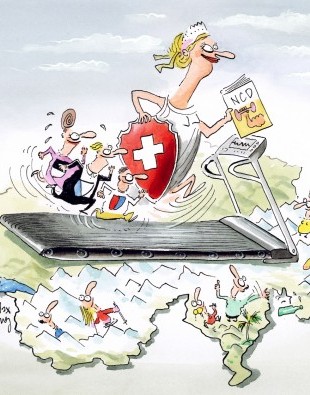
Many goals achieved – mixed outcomes at the political level
Avr. 2017End of the National Prevention Programmes
Interview with Andreas Balthasar. Andreas Balthasar assesses the alcohol, tobacco, and diet and exercise programmes as well as the package of drug measures after their first period. We asked him about his overall view of the programmes, where he thinks they have been particularly successful, what must be taken into account when establishing the objectives of an evaluation, and what he sees as the challenges for future prevention programmes.
spectra: How do you view the success of the programmes, now that they have been running for eight years?
Prof. Andreas Balthasar: The outcomes are mixed. The programmes have generally had positive results. The most important point is that the stakeholders, the NGOs and the authorities have jointly taken significant steps towards a common goal. The evaluations show that the defined outcome and output objectives were frequently achieved. The result is less clear at the political level. The programmes have contributed greatly to the strengthening of existing and new services. Some institutional objectives have also been achieved: protection against passive smoking is a good example. However, implementation is hampered by the political dynamics, and there have been some setbacks – particularly with regard to alcohol. For instance, the complete revision of the Alcohol Act would have incorporated structural measures for prevention, but it failed due to insurmountable differences. So much for a general overview.
A look at individual programmes shows that some of them have progressed further than others. The situation with drug problems has changed somewhat; new challenges have emerged. But the stakeholders in prevention now know quite well how to deal with this. With tobacco, the Federal Act on Protection against Passive Smoking is successfully reducing tobacco consumption in some important areas. However, it has also meant that nothing at all was achieved in other areas. Very little has changed with regard to alcohol issues. This is certainly due to the difficult environment. Good progress has been made in terms of nutrition and exercise, which is probably due to the collaboration with the cantons, with industry or with other federal offices. The indicators also show that the problem of overweight in children has improved somewhat.
Which programme measures have proven particularly successful, and which need new strategies for further development?
The measures that have proved to be useful are those developed jointly with the respective target groups. This will continue to apply in future. For example, if a prevention programme is developed together with general practitioners (GPs), it will probably be accepted by the majority of GPs and be effective. Peer-group approaches are also promising, for example programme development that involves school pupils or adolescents, who can also act as mediators. These processes are time-consuming, but they are quite promising approaches.
It is important to involve existing organizations and institutions such as primary medical care and the hospitals in prevention issues – and the NCD strategy (NCD = non-communicable disease) is definitely intended to do this. "Prevention in health care" is certainly an important pillar of the NCD strategy. I see this as promising.
It is important that the FOPH listens and finds out what is needed, but is also proactive in taking on new issues and is a bit more demanding. After all, the cantons have very different priorities for issues other than prevention. Cantonal health policy focuses on hospital financing and comprehensive health care, in other words the regions also need enough general practitioners. The federal government must support cantonal stakeholders who are active in prevention, but it must also put more pressure on the cantons and tell them: “Don’t forget, mental health is important and so is exercise: do something about it, we’ll support you!” This approach may be uncomfortable, but the FOPH will have to deal with it. No progress will be made in the area of health promotion and disease prevention if we wait for the cantons to make a decision. However, this is a difficult situation, which can’t be approached by all areas at the same time.
During the eight years that the programmes have been running, have you detected any social changes regarding the perception and consumption of legal or illegal substances, or the awareness and attitude to diet and exercise?
The main objective of tobacco prevention is to make non-smoking the norm. Important steps can be achieved in this respect, particularly in protection against passive smoking. However, people often say: " People aren’t allowed to smoke in indoor areas open to the public – what more do you want?” Many people say that the tobacco problem has been resolved. But that’s not true at all. You only need to look at other countries to see that the prevalence of smoking is comparatively high in Switzerland.
There are increasing concerns about alcohol. Negative comments about excessive alcohol consumption are taken more seriously now than in the past. But no political majorities are in favour of further restrictions. Institutional measures would be difficult, even if a night-time ban on the sale of alcohol has been introduced in retail shops in Geneva. This is a well-known issue, but we’re still waiting for progress at the political level. Measures for prevention are also countered by the resources of big business for advertising etc. Alcohol prevention has to confront strong countermeasures. I think the situation is similar to that for tobacco 20 to 30 years ago.
In general, it’s clear that there are social changes: they are partly due to the programmes, and partly to other factors. Of course the increasing influence of traditional citizens’ groups in parliament is holding back efforts for prevention. The new strategies are certainly needed, and political support in this respect is currently very weak. This means: stay on the ball, establish coalitions, and take small but significant steps!
And how does Switzerland rank internationally?
For tobacco and smoking, Switzerland ranks poorly by comparison with other countries. We have relatively liberal legislation, and Switzerland has still not ratified the WHO Convention on Tobacco Control, although it was signed years ago by the Federal Council. The prevalence of smoking is relatively high. Switzerland has certainly been a pioneer in the area of illegal drugs, but this no longer seems to be the case. Switzerland is well positioned with regard to exercise and diet. For example, the Youth+Sport programme is an important element of organised sport here, but we're also doing well with other significant activities.
As far as alcohol goes, I don't think that anyone has a solution. I was given some idea of this by participants in the master's course in Health Science in Lucerne. In one presentation, a local security officer argued for a ban after a certain time in the evening: he said that public spaces are quite polluted and hospital referrals are increasing dramatically. In the following discussion, a participant from Canada said that they had extremely restrictive laws on alcohol consumption by adolescents. But the teenagers were drunk anyway. A participant from Cuba then said that alcohol was not taboo there. People drank alcohol every day, even children were given rum – that was quite normal. At the end of the discussion, the conclusion was that excessive alcohol consumption is closely linked to people's prosperity. Most people have nothing against alcohol consumption for enjoyment, but with smoking, there's now a broad consensus that it endangers one's health.
From this year on, the national prevention programmes will become part of the National Addiction Strategy and the National Strategy for Prevention of Non-communicable Diseases. Which opportunities and risks do you see in these cohesive substance strategies as compared with the previous individual substance strategies?
A cohesive substance strategy is certainly the right approach from a scientific viewpoint. It's the state of the art. We must enable the public to lead a healthier lifestyle. A cohesive substance strategy is also needed by practitioners at the front line. That would involve teachers as well. They appreciate it if a single specially trained person speaks to students about all aspects of addiction. The cantons and their relevant departments also appreciate it if a single prevention specialist is involved in developing the rules and regulations. Science, practitioners and cantons: they all need and welcome an integrated strategy.
But here's the catch: NGOs that have worked towards prevention of a particular substance for years are tied to this particular substance. It's the basis of their legitimacy, their networks and their expertise. If I've been working towards alcohol prevention and supporting those affected for 20 years, it's very difficult to reposition myself and my institution and achieve legitimacy based on the objectives of the NCD strategy. We have to understand that a lot will be lost with the introduction of the cohesive substance strategy, such as existing commitments and positioning. That will have to be built up again, and that takes time. But of course it also creates opportunities and potential synergies, which will pay off in the medium and long term.
A particular challenge is that the concept of NCDs is difficult to grasp and communicate. The negative consequences of alcohol, tobacco and drugs – people already know that. Perhaps there's someone we know who has a drinking problem. We then might know from our own experience how difficult such situations can be, and we develop a certain sensitivity. We need to make it easier for people to understand what NCDs mean, and how important it is to have an appropriate strategy.
Is it really possible to measure the success of programmes?
One can measure the defined success of programmes relatively well. The only question is, how does one define success? We distinguish between output, outcome and impact.
Output is the results: who does what? Are people doing anything new, now that this programme is in place? That’s relatively easy to measure. The measurement doesn’t cost much and is often used in self-evaluations.
The outcome is found at the next level, in the target group. Is this affected? For example, is there a patient who was given advice based on a recently developed checklist for certain risk factors, and has changed his behaviour as a result? This is relatively easy to find out, but the methodology is rather time-consuming since it might require a survey.
But if the impact needs to be measured, in other words a desired effect on the population, such as a reduction of the prevalence of smoking in adolescents or a reduction of their average weight, it will be more difficult. The contribution of a complex prevention programme to a change in prevalence is usually difficult to estimate reliably. This is partly because prevention programmes often consist of a combination of measures whose specific effects are very difficult to isolate. But there are also numerous external factors that affect the behaviour and health of the population, which of course makes evaluating the effects of a programme more difficult, if not totally impossible. The relevant indicators must certainly be measured, addiction parameters must be monitored and so on. But in the end, a reliable correlation between a political programme and development of the monitoring data cannot be established. This is not necessarily a problem, because if the outputs and outcomes of the target group go in the right direction and the results of monitoring also go in the same direction, one can assume that the programme is making a contribution to the success.
Why do we need effect models?
Effect models are visualisations of the effect logic of a programme. They help to ensure that the people involved have a common understanding of what they want to achieve and how they want to achieve it. Those involved in prevention are often so busy with routine business that they lose sight of the big picture. It is very important to ask what my project contributes to the overall programme, which might, for example, implement dietary recommendations in children’s play groups. This means that the people involved see that their work helps to avoid overweight in children. The effect model, in which one distinguishes between the results and effects on the target group and the effects on society, is therefore an important tool for visualising and embedding activities in a complex context.
So effect models are good if they are created jointly by the parties involved, who regard this a process. Effect models also contribute to distinguishing important from less important factors and establishing priorities. An effect model with good visualisation is also valuable for communication – for campaigns, for political communication or for presenting programmes or strategies to the cantons. So an effect model doesn’t have to be complicated. And last but not least, a good effect model helps to show who should take which role. For example, this means that the relevant individuals in the FOPH know that they are responsible for fundamental principles, but not for other matters. Clear allocation of roles makes things easier for everyone involved.
The goals that the prevention programmes are intended to achieve always depend on the capability of the majority of the partners and finally on politics. How do you determine your objectives area with conflicting priorities?
The most important thing is to set realistic goals. But at the same time, the goals should involve a certain element of challenge. Objectives must be negotiated between the various stakeholders before they are set. It is also a good idea to review the objectives by means of regular self-evaluations. Specialists for strategy development and evaluation can provide useful advice for this process. Usually we have to say: "The objectives are too ambitious, that’s not realistic”. If I evaluate a four-year programme, at the end of the second year I need to make measurements, so that I have results in the third year. Decisions already have to be made at that stage on how the programme should proceed. Evaluations are often made early, for example after the programme has been running for two years. One must be aware that it can take well over a year until a program actually starts. So we shouldn’t be too ambitious with our objectives. Measurability is also a factor. The objectives must be measurable. Since evaluations tend to be time-consuming, when setting objectives one should already ask what data are already available and can be used, and what data must still be collected. For indicators of effects on the population, one usually relies on existing surveys – for example, in the health sector on the Swiss Health Survey or Swiss Addiction Monitoring etc.
Good cooperation between the FOPH and the partners is a critical factor for the success of any programme. How would you assess the FOPH's role allocation? Do you have any recommendations for the FOPH?
A success factor is already implemented in the NCD strategy. And it is this: seek cooperation with the cantons, professional associations, NGOs, business and all other relevant stakeholders, so that they can develop the programme together and make progress. I think that the challenge is that there are conflicting priorities. On the one hand the FOPH has the remit to improve the health of the population, and in this context to anticipate and take preventive measures for problems such as mental illness and the health effects of social isolation in old age. On the other hand, there are the politicians, who say: "Leave people in peace and stop giving them good advice. Freedom is what's important." Dealing with the tension between these two requirements is a major challenge for the public sector.
Our interviewee
Andreas Balthasar is Honorary Professor for Political Science (specialising in health policy) at the University of Lucerne. He founded Interface Politikstudien Forschung Beratung in Lucerne in 1991. He works primarily as an evaluation and strategy consultant for various federal departments. He also carries out research on social and health policy and is in charge of complex evaluations. Andreas Balthasar lives with his family in Lucerne.







